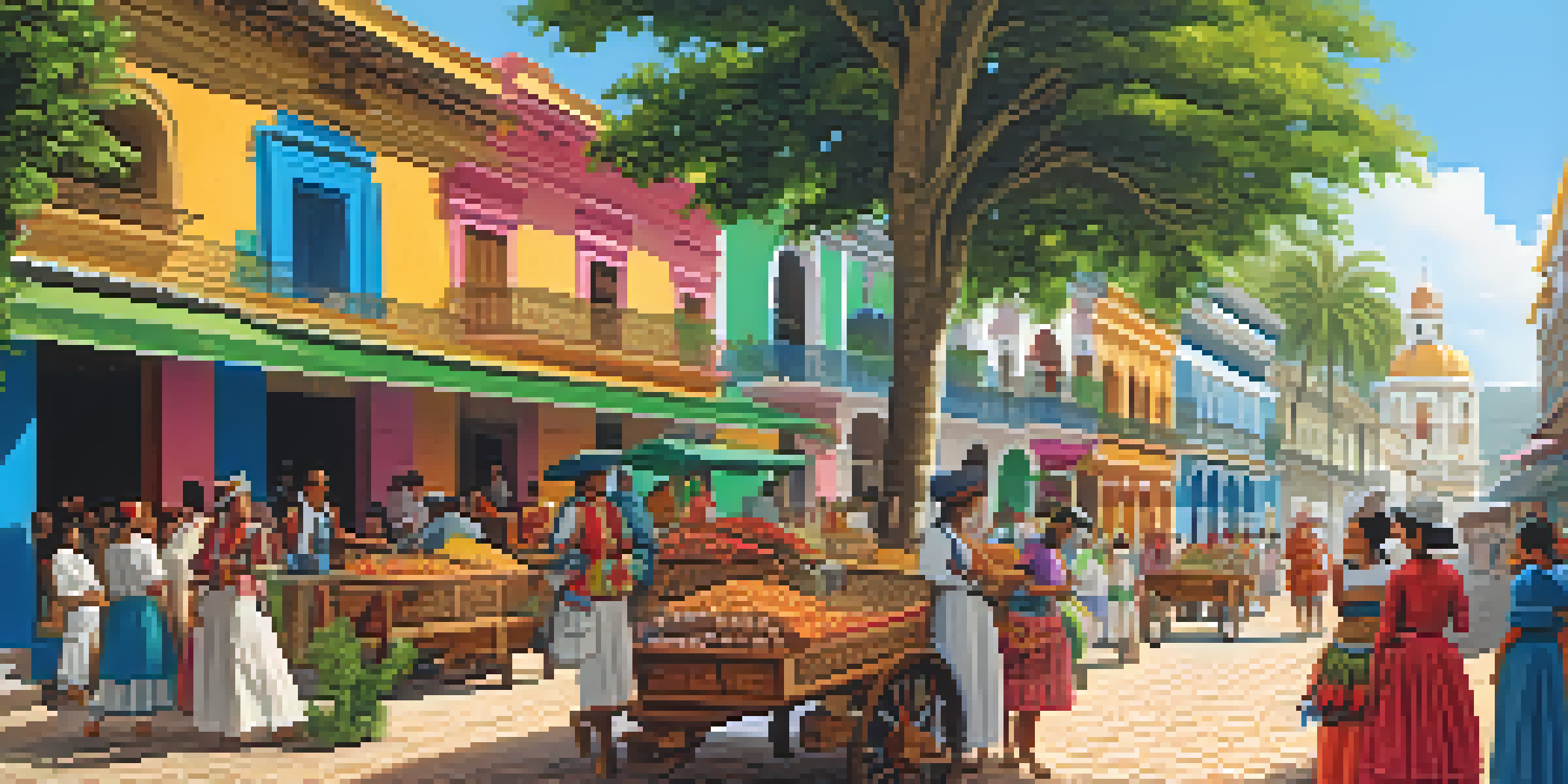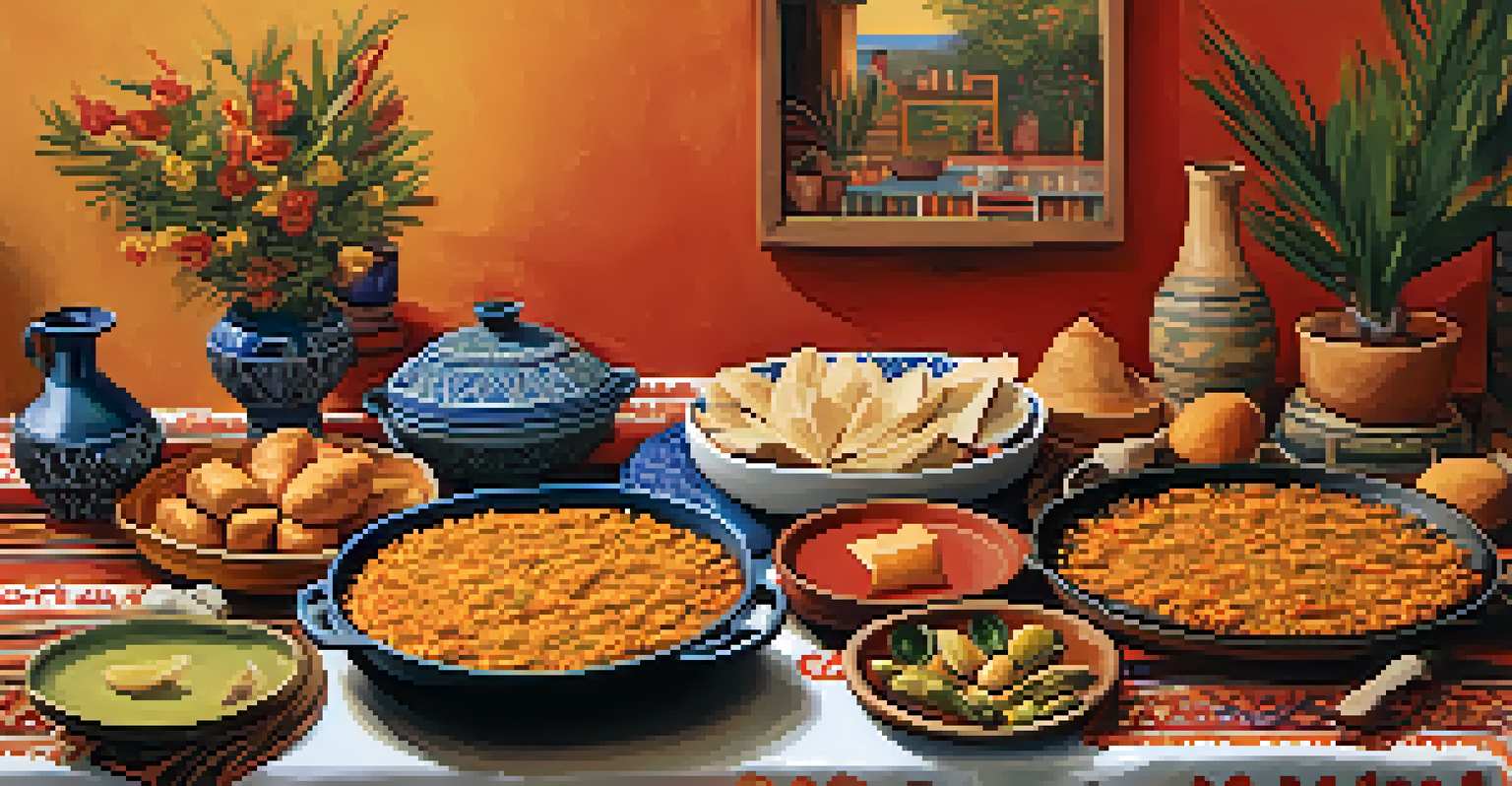Exploring the Impact of Spanish Colonial History on Culture

Understanding Spanish Colonial History and Its Beginnings
Spanish colonial history began in the late 15th century, with Christopher Columbus's voyages marking the start of European exploration in the Americas. This era was characterized by the establishment of vast empires, where Spain sought to expand its territories and influence. The consequences of these actions would not only affect indigenous populations but also lead to a cultural exchange that is still evident today.
History is written by the victors.
The motivations behind Spanish colonization were driven by a desire for wealth, religious conversion, and territorial expansion. Spanish conquistadors, like Hernán Cortés and Francisco Pizarro, played pivotal roles in the conquest of the Aztec and Inca empires respectively. These events set the stage for a complex interaction between the colonizers and the native inhabitants, which would deeply influence local cultures.
As Spain established its foothold in various regions, it brought with it language, religion, and customs that would intertwine with those of the indigenous people. This blending of cultures gave rise to new traditions, practices, and identities, shaping societies that reflect both their colonial past and indigenous roots.
Language and Its Evolution Through Colonial Influence
One of the most significant impacts of Spanish colonialism is the Spanish language itself. Today, Spanish is the second most spoken language in the world, thanks to the extensive reach of the Spanish Empire. The language not only serves as a means of communication but also embodies a rich cultural heritage that has evolved over centuries.

In many Latin American countries, Spanish has mingled with local languages, creating unique dialects and expressions. For instance, words from indigenous languages have been incorporated into everyday Spanish, showcasing a linguistic fusion that reflects a shared history. This blend enhances the richness of the Spanish language, making it a living testament to cultural interaction.
Cultural Fusion from Colonization
Spanish colonial history led to a rich blending of cultures, evident in language, religion, and culinary traditions.
Moreover, the spread of Spanish has influenced literature, music, and art across the globe. From the poetry of Pablo Neruda to the rhythms of flamenco, the Spanish language has become a vessel for expressing complex emotions and narratives that resonate deeply with diverse audiences.
Religion: The Role of Catholicism in Colonial Societies
Religion played a central role in the Spanish colonial enterprise, with Catholicism often being imposed on indigenous populations. The Spanish Crown funded missions to convert native peoples, leading to the establishment of numerous churches and cathedrals across the Americas. This religious fervor deeply impacted local cultures and belief systems.
We are all products of our history, and our history is a reflection of how we have lived.
The introduction of Catholicism led to the creation of syncretic religions, where indigenous beliefs were merged with Catholic practices. For example, the Day of the Dead in Mexico reflects a blend of Catholic and pre-Columbian traditions, showcasing how cultures can adapt and evolve through colonial influences. This fusion highlights the resilience of indigenous identities in the face of external pressures.
Today, Catholicism remains a dominant religion in many former Spanish colonies. Its influence extends beyond spirituality, shaping social norms, festivals, and community gatherings that continue to be celebrated with fervor, illustrating the enduring legacy of Spanish colonial history on cultural practices.
Culinary Traditions: A Melting Pot of Flavors
Spanish colonial history has profoundly influenced the culinary landscape of many regions. The introduction of new ingredients from Europe, such as olives, garlic, and various spices, combined with native foods led to the creation of distinctive dishes. This culinary fusion is a delicious testament to the cultural exchange that occurred during colonization.
In Latin America, for instance, staples like corn, beans, and potatoes were complemented by Spanish cooking techniques and flavors. Dishes such as paella in Spain and tamales in Mexico reflect this blending of culinary traditions, creating rich flavors that tell the story of their origins. Food thus becomes a medium through which history is tasted and experienced.
Art and Architecture's Legacy
The merging of European and indigenous styles during the colonial period created a unique artistic and architectural heritage.
Moreover, the popularity of Spanish cuisine has transcended borders, influencing global gastronomy. Tapas, for example, have gained international acclaim, showcasing how Spanish colonial history has shaped not just local but also global culinary practices, bringing people together through shared meals and flavors.
Art and Architecture: A Blend of Styles and Influences
The impact of Spanish colonial history is vividly evident in art and architecture across the Americas. The merging of European styles with indigenous artistry resulted in unique architectural forms, such as the baroque churches seen throughout Latin America. These structures not only serve religious purposes but also stand as symbols of cultural identity.
Art during the colonial period often depicted religious themes, but indigenous artists infused their work with local symbolism and techniques. This led to a rich tapestry of artistic expression that can be observed in paintings, sculptures, and textiles. The blending of styles created a distinctive artistic heritage that reflects both the colonial and indigenous narratives.
Today, this artistic legacy continues to inspire contemporary artists who draw from their rich cultural history. Festivals showcasing traditional dances, music, and crafts often highlight this blend of influences, allowing communities to celebrate their unique identities while acknowledging their historical roots.
Social Structures: The Hierarchies Established by Colonization
Spanish colonial history established complex social hierarchies that have had lasting impacts on contemporary societies. The caste system, which categorized individuals based on race and ancestry, created divisions that influenced social interactions and opportunities. This system has left a legacy of inequality that still resonates in many Latin American countries today.
The privileges granted to those of Spanish descent often marginalized indigenous populations and those of mixed heritage. As a result, social dynamics became intricately tied to race, shaping everything from politics to economic opportunities. This legacy has prompted ongoing discussions about social justice and equality in post-colonial societies.
Social Hierarchies and Inequality
The caste system established during colonization has resulted in lasting social divisions and discussions on inequality in modern societies.
In recent years, movements advocating for indigenous rights and recognition have emerged, highlighting the need to address historical injustices. These efforts seek to dismantle remnants of colonial social structures, fostering inclusivity and equality while promoting cultural pride among diverse communities.
Modern Cultural Identity: Reflecting on Colonial Heritage
Today, the impact of Spanish colonial history is woven into the fabric of modern cultural identities in many regions. People often navigate a complex blend of indigenous and colonial heritages, creating multifaceted identities that reflect their unique histories. This interplay of cultures can be seen in art, music, and daily life.
Festivals celebrating both indigenous and Spanish traditions highlight this cultural duality. Events such as Carnival in Brazil or Fiesta in San Antonio showcase the rich tapestry of influences that stem from colonial history. These celebrations serve as a reminder of collective resilience and the ongoing evolution of cultural expressions.

As societies continue to grapple with their colonial pasts, there is a growing appreciation for the richness that diversity brings. Embracing this dual heritage fosters a sense of belonging and pride, allowing individuals to honor both their indigenous roots and their colonial history.